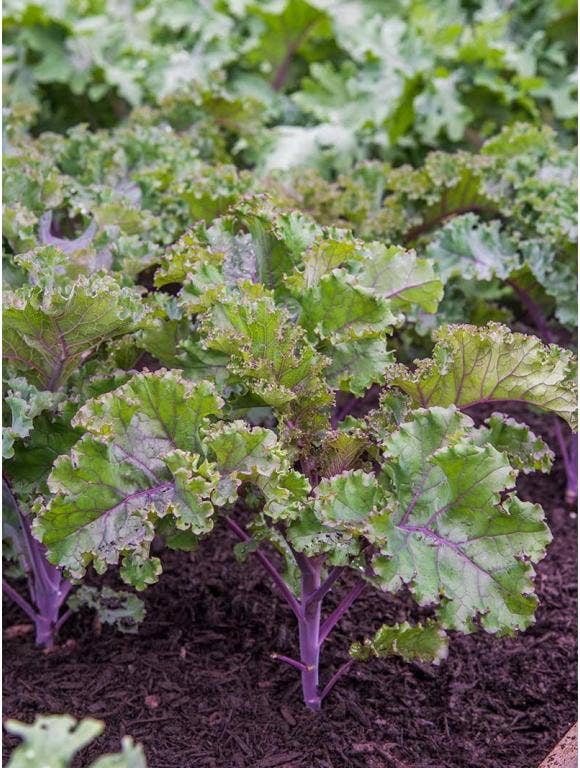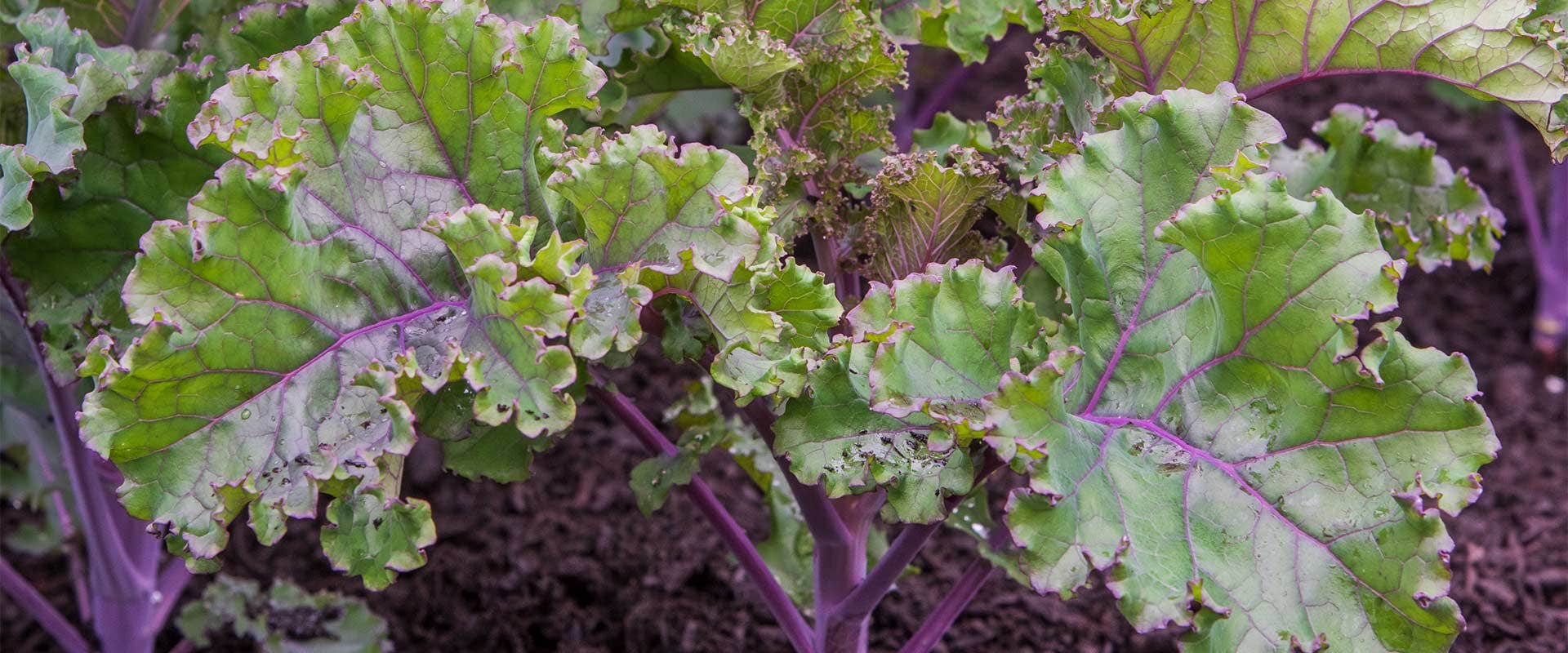


You may not be familiar with the term "cole crops," but you've likely planted some of them in your spring and fall gardens.
Cole crops — the most common and popular cruciferous vegetables, including cabbage, broccoli, cauliflower, Brussels sprouts, collards, kale and kohlrabi — are different cool season cultivars of the Brassica oleracea species, part of the Brassica genus and members of the Brassicaceae family of mustard plants. Although they may look and taste different, they're all descended from a single ancestral wild mustard plant.
Other notable members of the Brassicaceae family include Chinese cabbage (aka bok choy), turnips, rutabagas (whose origin is likely a cross between turnips and cabbage), radishes, Napa cabbage, arugula and mustard greens.
How Cole Crops Got Their Name
Known colloquially as "cole crops," the word "cole" comes from the Latin "caulis" meaning "stem" and the German word "kohl" for cabbage. It's where the shredded cabbage dish coleslaw gets its name. These cruciferous vegetables, or crucifers, were known in medieval times as "Cruciferae" (Latin for "cross-bearing") because their four-petalled yellow flowers resembled a crucifix.
It also makes sense that some people mistakenly refer to cole crops as "cold crops" or "cool crops," as these plants are often planted and harvested during cooler weather.
Cole Crops' History
Originating in coastal and western Europe, cabbage, kale and collard greens are some of the world's oldest cultivated crops, thought to have been domesticated sometime before 300 BCE.
Both broccoli and cauliflower come from the Mediterranean region. Broccoli was grown in ancient Roman times, but the first description of cauliflower didn't appear until 1544. Both are relative newcomers to the United States: Cauliflower first surfaced in the U.S. in the early part of the 20th century, and broccoli surfaced in the 1920s.
Although the vegetable's forbears likely originated in ancient Rome, Brussels sprouts are named for the city of Brussels in Belgium where they were cultivated widely during the 16th century. French settlers brought Brussels sprouts to Louisiana in the late 18th century long before cultivation began in 1925.
Benefits of Brassicas
Over several thousand years, Brassica oleracea has evolved into six major cultivars through selective breeding. We now grow and consume different parts of one common ancestral plant:
- Kale, collard greens and Chinese broccoli for the leaves
- Cabbage for the terminal (end) buds
- Brussels sprouts for the lateral (side) buds
- Kohlrabi for the stems
- Broccoli for the flowers and stems
- Cauliflower for the flower clusters
Each cultivar also has many sub-varieties — cabbage alone has over 400 that vary in shape from round to conical; have flat, curly, loose or tight leaves; and come in a range of colors, including green, white, red and purple.
For thousands of years and long before modern transportation and refrigeration, people stored these crops in root cellars for winter consumption to provide important nutrients when fresh vegetables were unavailable. Home gardeners can store fall-harvested cabbage for several months at 40 degrees Fahrenheit in high humidity or ferment them into sauerkraut or kimchi.
Your mother may have nagged you to eat your broccoli — with good reason. Brassicas are a great source of dietary fiber and are packed with vitamins and minerals, omega-3 fatty acids and antioxidants. They're also the only edible plants that contain glucosinolates, a unique phytochemical that acts as an anti-inflammatory and is also responsible for these plants' pungent aroma.
Cole Crop Growing Tips
Although they look different and we consume different parts of these plants, they all have similar growing requirements. Cool season biennials that are generally grown as annuals, brassicas have varying degrees of frost tolerance and thrive in temperatures between 60 F and 68 F. They perform best in full sun but will tolerate some shade.
If you're a beginner gardener, you'll likely enjoy success growing short-season brassicas like kale or bok choy. Cauliflower and broccoli can be finicky, requiring more detailed care and maybe a bit of luck too.
Optimal Growing Conditions for Brassicas
Brassicas are thirsty plants that need consistently moist but well-drained sandy, loam soil containing plenty of nutrient-rich organic matter. As most have shallow root systems, brassicas require 1 inch of water per week if rainfall hasn't provided it. They prefer slightly acidic soil with a pH of 6 to 6.8. As a lower pH will reduce yield, test your soil every few years, and if it's deficient in certain vital nutrients, amend it with lime, sulfur or other minerals. Mulching will help conserve water and reduce invasive weeds.
Direct-Sowing or Planting From Garden-Ready Plants
Many cole crops are more easily cultivated from transplants, but they'll also grow from direct sowing. Plants grown from garden-ready plants will be ready to harvest earlier than those sown directly. In spring, you can directly sow crops once the soil has reached 45 F. As you calculate the maturity date from the date of transplanting, add another 14 days if direct sowing.
Seed starting and transplanting will speed up the maturity and harvesting by three weeks. Start cabbage, cauliflower, Brussels sprouts, broccoli and kohlrabi seedlings indoors four to six weeks before planting or six to eight weeks before the last frost. To determine when to start fall crops in your area, check the days to maturity for a particular crop and count backward from your first average frost date.
About two weeks before planting, begin hardening off plants by giving them some time outdoors, increasing their time outside each day until they've acclimated.
Spacing
Refer to the planting instructions on the seed packet or transplant as each plant has slightly different requirements. But in general, most cole crops need 18 to 24 inches between plants and 24 to 36 inches between rows.
Fertilizing
Depending on soil test results, get the plants off to a good start by adding rich compost or 1 cup of organic all-purpose granular 4-4-4 fertilizer per 10-foot row, incorporating it into the top 4 to 6 inches of soil. Supplement plants with a small amount of balanced fertilizer about three to four weeks later.
Growing Brassicas Together
While it's OK to plant some brassicas together, there are also good arguments for keeping them separate. Brassicas are heavy feeders that can compete with each other for nutrients, especially nitrogen. Planting the same species together can also increase their vulnerability to infestation from brassica-loving insects.
Instead, plant a bed with one to two brassicas surrounded by some other mutually beneficial vegetable, herb and flower companions. Some studies have shown that planting edible and colorful nasturtiums will attract beetles, aphids and cabbage loopers away from the plants while also improving growth and flavor. Thyme and onion can reduce cabbage looper and imported cabbageworm damage, tansies can help ward off cutworms and sage can repel cabbage moths.
Rotate Your Crops
Avoid planting any brassica in a spot that another brassica occupied the previous year. To protect cole crops from disease and pests and to improve soil fertility, rotate their location on a two- to three-year cycle. Consider sowing them in soil previously planted with nitrogen-fixing legumes such as beans and peas that can help fortify plant roots. Covering beds with fabric floating row covers for the first month or more will protect the crops from the elements and from pests like cabbageworms.
When to Harvest Brassicas
Brassicas are hardy plants with a tolerance for cold, and a light frost improves their flavor.
Here's when to harvest cole crops:
- Cabbage: Harvest when the head is large and firm.
- Cauliflower: Harvest heads when they reach a diameter of 5 to 8 inches and before the segments begin to separate.
- Broccoli: Harvest when the head is 4 to 8 inches and compact, and before the small flower buds open up and show yellow.
- Brussels sprouts: Small cabbage-like sprouts will develop along the thick stem, maturing first at the plant's base. Remove the large leaves between the enlarging sprouts and harvest when they're firm and before they open up.
- Kale: Harvest any time leaves are large enough for your use: tender young leaves for salad and older leaves for cooking.
To provide continuous harvests and plenty of food on the table, practice succession planting by alternating shorter season crops such as kale with longer season varieties like Brussels sprouts.
Learn more about the health benefits of cole crops.



